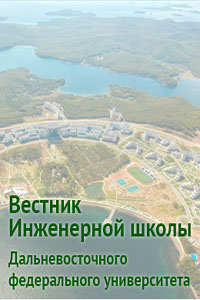Methodology for designing wear-resistant organo-inorganic materials to increase the durability of the “crankshaft-coating-bearing” liner tribocoupling of a medium-speed marine diesel engine
DOI:
https://doi.org/10.24866/2227-6858/2025-2/63-74Keywords:
vermiculite, chemical composition, modification, steel, coating, mechanical properties, wear rate, friction coefficientAbstract
The paper presents the author's research into the influence of the chemical composition of organo-inorganic materials used to form thin-film metal-ceramic coatings on steel and the mechanical characteristics of the coatings on the performance properties of the “crankshaft-coating-bearing” liner tribocoupling of a medium-speed marine diesel engine. The study of the influence of the chemical composition on the wear resistance of steel was carried out in two stages: during the formation of the coating and during tribological tests under friction conditions with boundary lubrication. To analyze the influence on the performance properties of the tribocoupling, the friction coefficient and mechanical characteristics of the metal-ceramic coatings were taken: the modulus of elasticity, microhardness and the value of elastic recovery of the coating. When forming a coating, the greatest influence on steel wear is exerted by the content of aluminum oxide and carbon, as well as the friction coefficient. It was found that the modulus of elasticity of the metal-ceramic coating has the greatest influence on the durability of the tribocoupling under friction conditions with boundary lubrication. Criterial values of mechanical properties of metal-ceramic coatings are determined to ensure a minimum value of its wear rate. The highest wear resistance is exhibited by coatings and mating surfaces when using vermiculite-based tribotechnical materials with a minimum value of elastic modulus and a high value of elastic recovery of the coating.
References
1. Леонтьев Л.Б., Леонтьев А.Л., Шапкин Н.П., Макаров В.Н., Молоков К.А., Болотова В.П. Влияние химического состава материала и физико-механических свойств покрытия на износостойкость трибоузла «вал – покрытие – вкладыш подшипника» // Вестник машиностроения. 2023. Т. 102, № 4. С. 326–329. DOI: https://doi.org/10.36652/0042-4633-2023-102-4-326-329
2. Леонтьев Л.Б., Шапкин Н.П., Леонтьев А.Л., Макаров В.Н., Токликишвили А.Г. Трибо-технические наноматериалы и надежность судовых дизелей: монография. Владивосток: ДВФУ, 2020. 277 с.
3. Усачев В.В., Погодаев Л.И., Телух Д.М., Кузьмин В.В. Введение в проблему использования природных слоистых геомодификаторов в трибосопряжениях // Трение и смазка в машинах и механизмах. 2010. № 1. С. 36–42.
4. Дунаев А.В., Ладиков В.В., Пустовой И.Ф., Голубев И.Г. Эффективность применения ми-неральных модификаторов при техническом сервисе в АПК. Москва: Росинформагротех, 2014. 164 с.
5. Колокатов А.М. Ремонтно-восстановительные составы для повышения ресурса машин. М.: Изд-во РГАУ-МСХА, 2016. 215 с.
6. Jaber M., Miehe-Brenble J., Roux M., Dentzer J. and other. A new Al, Mg-organoclay // New J. Chem. 2002. № 26. Р. 1597–1600.
7. Тушинский Л.И., Потеряев Ю.П. Проблемы материаловедения в трибологии. Новосибирск: НЭТИ, 1991. 64 с.
8. Кубич В.И., Ивщенко Л.И. О механических характеристиках приповерхностных слоев эле-ментов трибосопряжения «шейка – покрытие – вкладыш» // Проблемы трибологии. 2011. № 4. С. 97–102.
Downloads
Published
Issue
Section
License
Copyright (c) 2025 Far Eastern Federal University: School of Engineering Bulletin

This work is licensed under a Creative Commons Attribution 4.0 International License.

